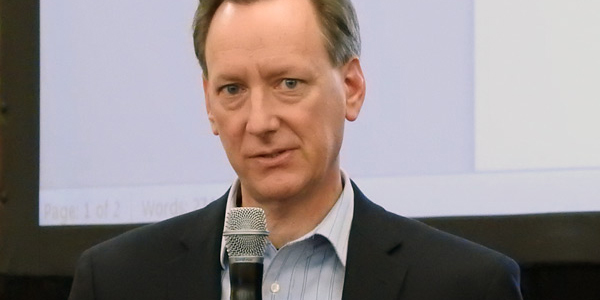By Michael Yoder
No PJM dispatchers have tested positive for COVID-19 yet, but RTO officials are planning just in case their luck runs out.
During the weekly coronavirus update Friday, PJM officials were asked how they would respond if a dispatcher tested positive for the virus.
Paul McGlynn, PJM’s executive director of system operations, said no control room workers have tested positive, but that the RTO has enough employees to fill gaps if someone becomes infected.
McGlynn said PJM’s control center best practices document includes procedures for bringing back former employees in an emergency. “We look at staff that has previously worked in the control room and develop plans to get them trained and ready so that they could go back on the board if needed,” McGlynn said.
Telecommuting Extended
Scott Heffentrager, PJM’s chief security officer, said the RTO is extending telecommuting for all personnel until May 4. Heffentrager said the telecommuting measure does not apply to the control room staff, IT operations center, security or other critical on-site support personnel.
Crews have been prepping the PJM campuses for more than a week for sequestration — healthy workers required to remain on site if the pandemic becomes worse — if it becomes necessary. Heffentrager said crews are installing temporary bedding, entertainment, food and other accommodations for employees.
“We have not made the decision to go to sequestration, but this was just to prep the campus in the event that we do pull the trigger to do that,” Heffentrager said.
Besides adding accommodations for employees, a team has also been working on converting PJM’s control room simulator to a potential third control room in case of an emergency. Heffentrager said the control room is currently being tested, and security and compliance teams are converting the room to a “physical security perimeter” to meet NERC standards.
Generator Outage Coordination
PJM’s David Schweizer updated stakeholders on generator outage coordination, saying most generators intend on going ahead with planned and maintenance outages despite the pandemic. He said the RTO continues to track any changes that members bring to PJM’s attention, including planned outages.
About 5% of the planned outages this spring have been canceled outright without being rescheduled, Schweizer said, with about 25% being deferred until later this spring, the fall and the spring of 2021. Schweizer said many generators are reducing the scope of the spring outages by supplementing them with short duration maintenance outages during off-peak hours.
PJM has also continued coordination with gas pipelines to make sure gas is still being sent to generators. Schweizer said teams are tracking any pipeline maintenance plans, especially those that could “affect generation in the PJM footprint.”
Stakeholders are continuing to compile best practice information through a survey of generators that was started last month, Schweizer said. The survey was designed to be a portal to provide supplemental information to PJM so that the RTO is aware of issues related to outages, complications with contractor availability and other support needs.
Schweizer said the questionnaire is meant to be a “dynamic, ongoing survey” that will be updated regularly. He said one of the biggest concerns that has been voiced by generators are supply chain problems for outage-related materials coming from outside the immediate area.
“I think the thing we’re seeing mostly is comments about contractor availability not being 100% assured due to the fact that many outages are relying on critical workforce and resources coming from out of state or even from overseas,” Schweizer said.
Load Modeling
Elizabeth Anastasio, PJM senior meteorologist, said long- and short-term load forecasters are attempting to determine the impact of COVID-19 by comparing actual load with historical temperature and load data.
Anastasio said forecasters have been seeing some trends in load forecast errors.
After the first two weeks of March, the error in one of the short-term models fluctuated between +2% and -2%, Anastasio said, averaging out to a bias near zero for the forecast model.
In the last two to three weeks of March, she said forecasters observed the forecast error increase in magnitude, seeing an error of 4 to 6% depending on the time of day. She said the error has largely remained positive in that time, as the “models are over-forecasting almost exclusively.”
Anastasio said the warmer-than-usual weather has been playing a role in lower load levels.
“We’re doing our best to figure out how much of our decrease in load is due to the warmer temperatures and how much is due to COVID-19,” she said.
Chris O’Leary of PSEG Energy Resources asked if Anastasio believes PJM will be able to quantify the effect of COVID-19 with the higher-than-normal March temperatures and other factors.
Yes, Anastasio said. At least three or four methodologies are being pursued, she said, with each one having limitations that include simplistic modeling and subjectivity.
“What we’ve seen from early results of this analysis is that many of the methodologies are converging on a similar solution,” Anastasio said. “I suspect that we’ll be able to present a little bit more in this line at our Operating Committee meeting presentation” on April 15.
Additional Updates
PJM’s Donnie Bielak provided an update on transmission outage coordination, saying most planned transmission upgrades are proceeding on schedule. Although some transmission operators decided in late March to defer nonessential work until later months, time-sensitive work is proceeding as planned, Bielak said.
Michael Hoke, PJM’s senior lead trainer, updated stakeholders on operator training schedules. Hoke said his team is in the process of finalizing online simulations. He said the online simulations are used for operators who need a certification renewal in the next month or two and need simulation hours to complete the process.




